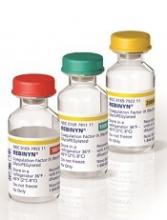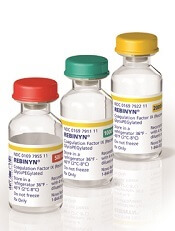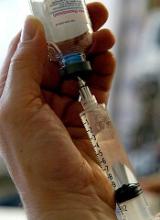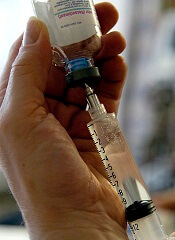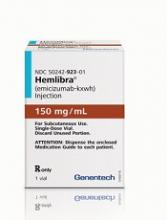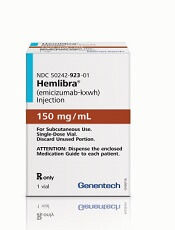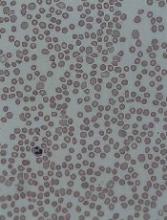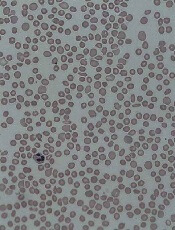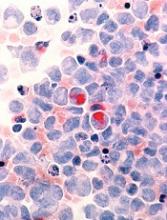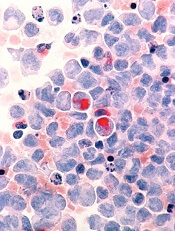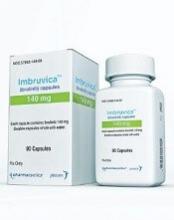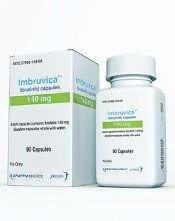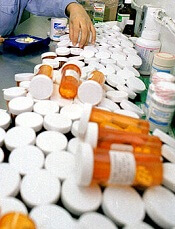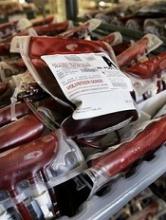User login
Gene therapy reduces ABR, AIR in hemophilia B
GLASGOW—New research suggests the gene therapy SPK-9001 can reduce bleeding and the need for factor IX infusions in patients with hemophilia B.
In an ongoing, phase 1/2 trial, SPK-9001 reduced the annualized bleeding rate (ABR) by 98% and the annualized infusion rate (AIR) by 99%.
All 15 patients treated with SPK-9001 have discontinued factor IX prophylaxis.
There have been no serious adverse events (AEs), no thrombotic events, and no factor IX inhibitors observed to date.
Spencer K. Sullivan, MD, of the Mississippi Center for Advanced Medicine in Madison, Mississippi, presented these results at the World Federation of Hemophilia (WFH) 2018 World Congress during the “Free Papers: Gene Therapy” session on Tuesday.
The research was sponsored by Spark Therapeutics, the company developing SPK-9001 in collaboration with Pfizer.
SPK-9001 is an investigational vector that contains a bio-engineered adeno-associated virus capsid and a codon-optimized, high-activity human factor IX gene enabling endogenous production of factor IX.
Dr Sullivan reported results with SPK-9001 in 15 patients with severe or moderately severe hemophilia B.
As of the May 7, 2018, data cutoff, there were 13 patients with at least 12 weeks of follow-up after SPK-9001 infusion, which is the length of time required to achieve steady-state factor IX activity levels. All 13 patients reached stable factor IX levels of more than 12%.
The range of steady-state factor IX activity level, beginning at 12 weeks through 52 weeks of follow-up for the first 10 patients infused, was 14.3% to 76.8%.
The next 3 patients were infused with SPK-9001 manufactured using an enhanced process and reached 12 or more weeks of follow-up. For these patients, the range of steady-state factor IX activity level was 38.1% to 54.5%.
The 2 remaining patients had only 5 weeks and 11 weeks of follow-up as of the cut-off date.
Based on individual participant history for the year prior to the study, the overall ABR for all 15 patients was reduced by 98% four weeks after SPK-9001 treatment.
The ABR was 0.2 bleeds per patient after SPK-9001, compared to an ABR of 8.9 before SPK-9001.
One patient experienced a bleeding event 4 or more weeks after SPK-9001 infusion.
The overall AIR was reduced by 99% (based on data after week 4) for all 15 patients. The AIR was 0.9 infusions per patient after SPK-9001, compared to 57.2 infusions before SPK-9001.
Six patients received factor IX infusions following SPK-9001 administration—2 for reported spontaneous bleeds, 2 prior to surgery, 1 at the end of the study (discretionary, per protocol), and 1 for prophylaxis for a minor, traumatic non-bleeding event.
However, all 15 patients have discontinued regular factor IX prophylaxis.
There have been no serious AEs or factor IX inhibitors reported.
Two patients (1 who received SPK-9001 manufactured using the enhanced process) experienced related AEs of elevated transaminases, which were asymptomatic.
These patients were treated with a tapering course of oral corticosteroids, and 1 event resolved before the data cutoff.
An additional patient received a tapering course of oral corticosteroids for an increase in liver enzymes (not exceeding the upper limit of normal) temporally associated with falling levels of factor IX activity.
“We are pleased to see all 15 participants, notably including the first 4 participants who have been followed for more than 2 years, continue to show that a single administration of SPK-9001 has resulted in dramatic reductions in bleeding and factor IX infusions, with no serious adverse events,” said Katherine A. High, MD, president and head of research & development at Spark Therapeutics.
“Our commitment to gene therapy research across our hemophilia programs remains steadfast with the goal of developing a novel therapeutic approach with a positive benefit-risk profile that aims to free patients of the need for regular infusions, while eliminating spontaneous bleeding.”
GLASGOW—New research suggests the gene therapy SPK-9001 can reduce bleeding and the need for factor IX infusions in patients with hemophilia B.
In an ongoing, phase 1/2 trial, SPK-9001 reduced the annualized bleeding rate (ABR) by 98% and the annualized infusion rate (AIR) by 99%.
All 15 patients treated with SPK-9001 have discontinued factor IX prophylaxis.
There have been no serious adverse events (AEs), no thrombotic events, and no factor IX inhibitors observed to date.
Spencer K. Sullivan, MD, of the Mississippi Center for Advanced Medicine in Madison, Mississippi, presented these results at the World Federation of Hemophilia (WFH) 2018 World Congress during the “Free Papers: Gene Therapy” session on Tuesday.
The research was sponsored by Spark Therapeutics, the company developing SPK-9001 in collaboration with Pfizer.
SPK-9001 is an investigational vector that contains a bio-engineered adeno-associated virus capsid and a codon-optimized, high-activity human factor IX gene enabling endogenous production of factor IX.
Dr Sullivan reported results with SPK-9001 in 15 patients with severe or moderately severe hemophilia B.
As of the May 7, 2018, data cutoff, there were 13 patients with at least 12 weeks of follow-up after SPK-9001 infusion, which is the length of time required to achieve steady-state factor IX activity levels. All 13 patients reached stable factor IX levels of more than 12%.
The range of steady-state factor IX activity level, beginning at 12 weeks through 52 weeks of follow-up for the first 10 patients infused, was 14.3% to 76.8%.
The next 3 patients were infused with SPK-9001 manufactured using an enhanced process and reached 12 or more weeks of follow-up. For these patients, the range of steady-state factor IX activity level was 38.1% to 54.5%.
The 2 remaining patients had only 5 weeks and 11 weeks of follow-up as of the cut-off date.
Based on individual participant history for the year prior to the study, the overall ABR for all 15 patients was reduced by 98% four weeks after SPK-9001 treatment.
The ABR was 0.2 bleeds per patient after SPK-9001, compared to an ABR of 8.9 before SPK-9001.
One patient experienced a bleeding event 4 or more weeks after SPK-9001 infusion.
The overall AIR was reduced by 99% (based on data after week 4) for all 15 patients. The AIR was 0.9 infusions per patient after SPK-9001, compared to 57.2 infusions before SPK-9001.
Six patients received factor IX infusions following SPK-9001 administration—2 for reported spontaneous bleeds, 2 prior to surgery, 1 at the end of the study (discretionary, per protocol), and 1 for prophylaxis for a minor, traumatic non-bleeding event.
However, all 15 patients have discontinued regular factor IX prophylaxis.
There have been no serious AEs or factor IX inhibitors reported.
Two patients (1 who received SPK-9001 manufactured using the enhanced process) experienced related AEs of elevated transaminases, which were asymptomatic.
These patients were treated with a tapering course of oral corticosteroids, and 1 event resolved before the data cutoff.
An additional patient received a tapering course of oral corticosteroids for an increase in liver enzymes (not exceeding the upper limit of normal) temporally associated with falling levels of factor IX activity.
“We are pleased to see all 15 participants, notably including the first 4 participants who have been followed for more than 2 years, continue to show that a single administration of SPK-9001 has resulted in dramatic reductions in bleeding and factor IX infusions, with no serious adverse events,” said Katherine A. High, MD, president and head of research & development at Spark Therapeutics.
“Our commitment to gene therapy research across our hemophilia programs remains steadfast with the goal of developing a novel therapeutic approach with a positive benefit-risk profile that aims to free patients of the need for regular infusions, while eliminating spontaneous bleeding.”
GLASGOW—New research suggests the gene therapy SPK-9001 can reduce bleeding and the need for factor IX infusions in patients with hemophilia B.
In an ongoing, phase 1/2 trial, SPK-9001 reduced the annualized bleeding rate (ABR) by 98% and the annualized infusion rate (AIR) by 99%.
All 15 patients treated with SPK-9001 have discontinued factor IX prophylaxis.
There have been no serious adverse events (AEs), no thrombotic events, and no factor IX inhibitors observed to date.
Spencer K. Sullivan, MD, of the Mississippi Center for Advanced Medicine in Madison, Mississippi, presented these results at the World Federation of Hemophilia (WFH) 2018 World Congress during the “Free Papers: Gene Therapy” session on Tuesday.
The research was sponsored by Spark Therapeutics, the company developing SPK-9001 in collaboration with Pfizer.
SPK-9001 is an investigational vector that contains a bio-engineered adeno-associated virus capsid and a codon-optimized, high-activity human factor IX gene enabling endogenous production of factor IX.
Dr Sullivan reported results with SPK-9001 in 15 patients with severe or moderately severe hemophilia B.
As of the May 7, 2018, data cutoff, there were 13 patients with at least 12 weeks of follow-up after SPK-9001 infusion, which is the length of time required to achieve steady-state factor IX activity levels. All 13 patients reached stable factor IX levels of more than 12%.
The range of steady-state factor IX activity level, beginning at 12 weeks through 52 weeks of follow-up for the first 10 patients infused, was 14.3% to 76.8%.
The next 3 patients were infused with SPK-9001 manufactured using an enhanced process and reached 12 or more weeks of follow-up. For these patients, the range of steady-state factor IX activity level was 38.1% to 54.5%.
The 2 remaining patients had only 5 weeks and 11 weeks of follow-up as of the cut-off date.
Based on individual participant history for the year prior to the study, the overall ABR for all 15 patients was reduced by 98% four weeks after SPK-9001 treatment.
The ABR was 0.2 bleeds per patient after SPK-9001, compared to an ABR of 8.9 before SPK-9001.
One patient experienced a bleeding event 4 or more weeks after SPK-9001 infusion.
The overall AIR was reduced by 99% (based on data after week 4) for all 15 patients. The AIR was 0.9 infusions per patient after SPK-9001, compared to 57.2 infusions before SPK-9001.
Six patients received factor IX infusions following SPK-9001 administration—2 for reported spontaneous bleeds, 2 prior to surgery, 1 at the end of the study (discretionary, per protocol), and 1 for prophylaxis for a minor, traumatic non-bleeding event.
However, all 15 patients have discontinued regular factor IX prophylaxis.
There have been no serious AEs or factor IX inhibitors reported.
Two patients (1 who received SPK-9001 manufactured using the enhanced process) experienced related AEs of elevated transaminases, which were asymptomatic.
These patients were treated with a tapering course of oral corticosteroids, and 1 event resolved before the data cutoff.
An additional patient received a tapering course of oral corticosteroids for an increase in liver enzymes (not exceeding the upper limit of normal) temporally associated with falling levels of factor IX activity.
“We are pleased to see all 15 participants, notably including the first 4 participants who have been followed for more than 2 years, continue to show that a single administration of SPK-9001 has resulted in dramatic reductions in bleeding and factor IX infusions, with no serious adverse events,” said Katherine A. High, MD, president and head of research & development at Spark Therapeutics.
“Our commitment to gene therapy research across our hemophilia programs remains steadfast with the goal of developing a novel therapeutic approach with a positive benefit-risk profile that aims to free patients of the need for regular infusions, while eliminating spontaneous bleeding.”
N9-GP has better PK profile than rFIXFc, team says
GLASGOW—Nonacog beta pegol (N9-GP) has a better pharmacokinetic (PK) profile than recombinant factor IX-Fc fusion protein (rFIXFc), according to researchers.
In a phase 1 trial, adults with hemophilia B who received a single dose of N9-GP achieved greater total factor IX exposure than those treated with rFIXFc, and N9-GP had a longer half-life.
Seven days after injection, factor IX activity was 6-fold greater in patients treated with N9-GP than in those treated with rFIXFc at the same dose.
“As a clinician, I know first-hand how challenging it can be to help people living with hemophilia B reach their treatment goals and be adequately protected from bleeding,” said Carmen Escuriola Ettingshausen, MD, of Haemophilia Centre Rhein Main in Frankfurt-Mörfelden, Germany.
“These data will help us better understand the different treatment options and choose the appropriate treatment for each patient.”
Dr Ettingshausen presented the data at the World Federation of Hemophilia (WFH) 2018 World Congress during the late-breaking abstract session on Monday.
The research was sponsored by Novo Nordisk A/S, the company marketing N9-GP (as Rebinyn or Refixia). N9-GP is an extended half-life factor IX molecule intended for replacement therapy in patients with hemophilia B.
In the Paradigm7 trial, researchers compared the PK profiles of N9-GP and rFIXFc (Alprolix).
Fifteen previously treated adult males with congenital hemophilia B (factor IX activity ≤2%) received single injections (50 IU/kg) of N9-GP and rFIXFc with at least 21 days between doses.
One patient was excluded from the analysis due to intake of a prohibited medication (an rFIXFc product that was not Alprolix). Two other patients were excluded from some analyses because they missed 2 PK time points.
The primary endpoint was dose-normalized area under the factor IX activity-time curve from 0 to infinity (AUC0-inf,norm).
The estimated AUC0-inf,norm (n=12) was significantly higher for N9-GP than rFIXFc—9656 IU*h/dL and 2199 IU*h/dL, respectively (ratio=4.39, P<0.0001).
There were significant differences for secondary endpoints as well.
The maximum factor IX activity dose-normalized to 50 IU/kg (n=14) was 91 IU/dL with N9-GP and 45 IU/dL with rFIXFc (ratio=2.02, P<0.001).
The incremental recovery at 30 minutes (n=14) was 1.7 (IU/dL)/(IU/kg) with N9-GP and 0.8 (IU/dL)/(IU/kg) with rFIXFc (ratio=2.20, P<0.001).
The terminal half-life (n=12) was 103.2 hours with N9-GP and 84.9 hours with rFIXFc (ratio=1.22, P<0.001).
The clearance (n=12) was 0.52 mL/h/kg with N9-GP and 2.25 mL/h/kg with rFIXFc (ratio=0.23, P<0.001).
The factor IX activity at 168 hours (n=12) was 19 IU/dL with N9-GP and 3 IU/dL with rFIXFc (ratio=5.80, P<0.001).
None of the patients developed inhibitors, and no safety concerns were identified, according to Novo Nordisk. The company did not provide additional safety information.
GLASGOW—Nonacog beta pegol (N9-GP) has a better pharmacokinetic (PK) profile than recombinant factor IX-Fc fusion protein (rFIXFc), according to researchers.
In a phase 1 trial, adults with hemophilia B who received a single dose of N9-GP achieved greater total factor IX exposure than those treated with rFIXFc, and N9-GP had a longer half-life.
Seven days after injection, factor IX activity was 6-fold greater in patients treated with N9-GP than in those treated with rFIXFc at the same dose.
“As a clinician, I know first-hand how challenging it can be to help people living with hemophilia B reach their treatment goals and be adequately protected from bleeding,” said Carmen Escuriola Ettingshausen, MD, of Haemophilia Centre Rhein Main in Frankfurt-Mörfelden, Germany.
“These data will help us better understand the different treatment options and choose the appropriate treatment for each patient.”
Dr Ettingshausen presented the data at the World Federation of Hemophilia (WFH) 2018 World Congress during the late-breaking abstract session on Monday.
The research was sponsored by Novo Nordisk A/S, the company marketing N9-GP (as Rebinyn or Refixia). N9-GP is an extended half-life factor IX molecule intended for replacement therapy in patients with hemophilia B.
In the Paradigm7 trial, researchers compared the PK profiles of N9-GP and rFIXFc (Alprolix).
Fifteen previously treated adult males with congenital hemophilia B (factor IX activity ≤2%) received single injections (50 IU/kg) of N9-GP and rFIXFc with at least 21 days between doses.
One patient was excluded from the analysis due to intake of a prohibited medication (an rFIXFc product that was not Alprolix). Two other patients were excluded from some analyses because they missed 2 PK time points.
The primary endpoint was dose-normalized area under the factor IX activity-time curve from 0 to infinity (AUC0-inf,norm).
The estimated AUC0-inf,norm (n=12) was significantly higher for N9-GP than rFIXFc—9656 IU*h/dL and 2199 IU*h/dL, respectively (ratio=4.39, P<0.0001).
There were significant differences for secondary endpoints as well.
The maximum factor IX activity dose-normalized to 50 IU/kg (n=14) was 91 IU/dL with N9-GP and 45 IU/dL with rFIXFc (ratio=2.02, P<0.001).
The incremental recovery at 30 minutes (n=14) was 1.7 (IU/dL)/(IU/kg) with N9-GP and 0.8 (IU/dL)/(IU/kg) with rFIXFc (ratio=2.20, P<0.001).
The terminal half-life (n=12) was 103.2 hours with N9-GP and 84.9 hours with rFIXFc (ratio=1.22, P<0.001).
The clearance (n=12) was 0.52 mL/h/kg with N9-GP and 2.25 mL/h/kg with rFIXFc (ratio=0.23, P<0.001).
The factor IX activity at 168 hours (n=12) was 19 IU/dL with N9-GP and 3 IU/dL with rFIXFc (ratio=5.80, P<0.001).
None of the patients developed inhibitors, and no safety concerns were identified, according to Novo Nordisk. The company did not provide additional safety information.
GLASGOW—Nonacog beta pegol (N9-GP) has a better pharmacokinetic (PK) profile than recombinant factor IX-Fc fusion protein (rFIXFc), according to researchers.
In a phase 1 trial, adults with hemophilia B who received a single dose of N9-GP achieved greater total factor IX exposure than those treated with rFIXFc, and N9-GP had a longer half-life.
Seven days after injection, factor IX activity was 6-fold greater in patients treated with N9-GP than in those treated with rFIXFc at the same dose.
“As a clinician, I know first-hand how challenging it can be to help people living with hemophilia B reach their treatment goals and be adequately protected from bleeding,” said Carmen Escuriola Ettingshausen, MD, of Haemophilia Centre Rhein Main in Frankfurt-Mörfelden, Germany.
“These data will help us better understand the different treatment options and choose the appropriate treatment for each patient.”
Dr Ettingshausen presented the data at the World Federation of Hemophilia (WFH) 2018 World Congress during the late-breaking abstract session on Monday.
The research was sponsored by Novo Nordisk A/S, the company marketing N9-GP (as Rebinyn or Refixia). N9-GP is an extended half-life factor IX molecule intended for replacement therapy in patients with hemophilia B.
In the Paradigm7 trial, researchers compared the PK profiles of N9-GP and rFIXFc (Alprolix).
Fifteen previously treated adult males with congenital hemophilia B (factor IX activity ≤2%) received single injections (50 IU/kg) of N9-GP and rFIXFc with at least 21 days between doses.
One patient was excluded from the analysis due to intake of a prohibited medication (an rFIXFc product that was not Alprolix). Two other patients were excluded from some analyses because they missed 2 PK time points.
The primary endpoint was dose-normalized area under the factor IX activity-time curve from 0 to infinity (AUC0-inf,norm).
The estimated AUC0-inf,norm (n=12) was significantly higher for N9-GP than rFIXFc—9656 IU*h/dL and 2199 IU*h/dL, respectively (ratio=4.39, P<0.0001).
There were significant differences for secondary endpoints as well.
The maximum factor IX activity dose-normalized to 50 IU/kg (n=14) was 91 IU/dL with N9-GP and 45 IU/dL with rFIXFc (ratio=2.02, P<0.001).
The incremental recovery at 30 minutes (n=14) was 1.7 (IU/dL)/(IU/kg) with N9-GP and 0.8 (IU/dL)/(IU/kg) with rFIXFc (ratio=2.20, P<0.001).
The terminal half-life (n=12) was 103.2 hours with N9-GP and 84.9 hours with rFIXFc (ratio=1.22, P<0.001).
The clearance (n=12) was 0.52 mL/h/kg with N9-GP and 2.25 mL/h/kg with rFIXFc (ratio=0.23, P<0.001).
The factor IX activity at 168 hours (n=12) was 19 IU/dL with N9-GP and 3 IU/dL with rFIXFc (ratio=5.80, P<0.001).
None of the patients developed inhibitors, and no safety concerns were identified, according to Novo Nordisk. The company did not provide additional safety information.
Therapy can extend half-life of FVIII
GLASGOW—Preliminary data suggest an investigational therapy can extend the half-life of factor VIII (FVIII) in patients with severe hemophilia A.
Researchers are testing the therapy, BIVV001, in a phase 1/2a trial and have reported results in 4 patients.
BIVV001 extended the half-life of FVIII to 37 hours, with an average FVIII activity of 5.6% at 7 days post-infusion.
“For decades, scientists have been trying to overcome the von Willebrand factor ceiling, which imposes a limit on the half-life of FVIII, and these data demonstrate that BIVV001 has finally broken through that ceiling,” said Joachim Fruebis, PhD, senior vice president of development at Bioverativ Inc.
Dr Fruebis presented these data at the World Federation of Hemophilia (WFH) 2018 World Congress during the late-breaking abstract session on Monday.
The research was sponsored by Bioverativ, the company developing BIVV001.
BIVV001 (rFVIIIFc-VWF-XTEN) is a recombinant FVIII therapy that builds on Fc fusion technology by adding a region of von Willebrand factor and XTEN polypeptides to potentially extend its time in circulation.
In the phase 1/2a EXTEN-A trial, researchers are evaluating the safety and pharmacokinetics of BIVV001 in a low-dose and high-dose cohort of subjects, ages 18 to 65, who have severe hemophilia A.
In the data presented at the WFH World Congress, 4 adult males received a single dose of recombinant FVIII therapy (25 IU/kg) followed, after a washout period, by a single, low dose of BIVV001 (25 IU/kg).
Primary endpoints of this study include the occurrence of adverse events and the development of inhibitors.
No inhibitors have been detected, and BIBV001 was “generally well-tolerated,” according to Bioverativ. The company did not provide additional safety information.
BIVV001 extended the half-life of FVIII to 37 hours, which is an increase over the 13 hours seen with recombinant FVIII.
The average FVIII activity for the 4 subjects was 13.0% at 5 days and 5.6% at 7 days post-infusion.
“Importantly for the hemophilia community, the factor levels seen in this study are unparalleled in hemophilia A,” Dr Fruebis said, “and we are excited about the potential for BIVV001 to transform the treatment paradigm for patients and physicians.”
GLASGOW—Preliminary data suggest an investigational therapy can extend the half-life of factor VIII (FVIII) in patients with severe hemophilia A.
Researchers are testing the therapy, BIVV001, in a phase 1/2a trial and have reported results in 4 patients.
BIVV001 extended the half-life of FVIII to 37 hours, with an average FVIII activity of 5.6% at 7 days post-infusion.
“For decades, scientists have been trying to overcome the von Willebrand factor ceiling, which imposes a limit on the half-life of FVIII, and these data demonstrate that BIVV001 has finally broken through that ceiling,” said Joachim Fruebis, PhD, senior vice president of development at Bioverativ Inc.
Dr Fruebis presented these data at the World Federation of Hemophilia (WFH) 2018 World Congress during the late-breaking abstract session on Monday.
The research was sponsored by Bioverativ, the company developing BIVV001.
BIVV001 (rFVIIIFc-VWF-XTEN) is a recombinant FVIII therapy that builds on Fc fusion technology by adding a region of von Willebrand factor and XTEN polypeptides to potentially extend its time in circulation.
In the phase 1/2a EXTEN-A trial, researchers are evaluating the safety and pharmacokinetics of BIVV001 in a low-dose and high-dose cohort of subjects, ages 18 to 65, who have severe hemophilia A.
In the data presented at the WFH World Congress, 4 adult males received a single dose of recombinant FVIII therapy (25 IU/kg) followed, after a washout period, by a single, low dose of BIVV001 (25 IU/kg).
Primary endpoints of this study include the occurrence of adverse events and the development of inhibitors.
No inhibitors have been detected, and BIBV001 was “generally well-tolerated,” according to Bioverativ. The company did not provide additional safety information.
BIVV001 extended the half-life of FVIII to 37 hours, which is an increase over the 13 hours seen with recombinant FVIII.
The average FVIII activity for the 4 subjects was 13.0% at 5 days and 5.6% at 7 days post-infusion.
“Importantly for the hemophilia community, the factor levels seen in this study are unparalleled in hemophilia A,” Dr Fruebis said, “and we are excited about the potential for BIVV001 to transform the treatment paradigm for patients and physicians.”
GLASGOW—Preliminary data suggest an investigational therapy can extend the half-life of factor VIII (FVIII) in patients with severe hemophilia A.
Researchers are testing the therapy, BIVV001, in a phase 1/2a trial and have reported results in 4 patients.
BIVV001 extended the half-life of FVIII to 37 hours, with an average FVIII activity of 5.6% at 7 days post-infusion.
“For decades, scientists have been trying to overcome the von Willebrand factor ceiling, which imposes a limit on the half-life of FVIII, and these data demonstrate that BIVV001 has finally broken through that ceiling,” said Joachim Fruebis, PhD, senior vice president of development at Bioverativ Inc.
Dr Fruebis presented these data at the World Federation of Hemophilia (WFH) 2018 World Congress during the late-breaking abstract session on Monday.
The research was sponsored by Bioverativ, the company developing BIVV001.
BIVV001 (rFVIIIFc-VWF-XTEN) is a recombinant FVIII therapy that builds on Fc fusion technology by adding a region of von Willebrand factor and XTEN polypeptides to potentially extend its time in circulation.
In the phase 1/2a EXTEN-A trial, researchers are evaluating the safety and pharmacokinetics of BIVV001 in a low-dose and high-dose cohort of subjects, ages 18 to 65, who have severe hemophilia A.
In the data presented at the WFH World Congress, 4 adult males received a single dose of recombinant FVIII therapy (25 IU/kg) followed, after a washout period, by a single, low dose of BIVV001 (25 IU/kg).
Primary endpoints of this study include the occurrence of adverse events and the development of inhibitors.
No inhibitors have been detected, and BIBV001 was “generally well-tolerated,” according to Bioverativ. The company did not provide additional safety information.
BIVV001 extended the half-life of FVIII to 37 hours, which is an increase over the 13 hours seen with recombinant FVIII.
The average FVIII activity for the 4 subjects was 13.0% at 5 days and 5.6% at 7 days post-infusion.
“Importantly for the hemophilia community, the factor levels seen in this study are unparalleled in hemophilia A,” Dr Fruebis said, “and we are excited about the potential for BIVV001 to transform the treatment paradigm for patients and physicians.”
Early infection could prevent ALL, doc says
Childhood acute lymphoblastic leukemia (ALL) may be preventable, according to a researcher.
Mel Greaves, PhD, of The Institute of Cancer Research in London, UK, reviewed more than 30 years of research and concluded that ALL develops in 2 steps—genetic mutation before birth and further genetic change after birth triggered by infection.
The evidence suggests that infection early in life is beneficial to prime the immune system, but later infection without earlier priming can trigger ALL.
So priming the immune system in the first year of life could potentially prevent childhood ALL, according to Dr Greaves.
He outlined this theory in Nature Reviews Cancer.
Dr Greaves compiled more than 30 years of research into genetics, cell biology, immunology, epidemiology, and animal modelling of ALL.
The evidence led him to conclude that ALL begins with a genetic mutation that occurs before birth and predisposes a child to leukemia.
The disease is triggered later, in childhood, by exposure to one or more common infections. This primarily occurs in children who experienced “clean” childhoods in their first year of life, without much interaction with other infants or older children.
Dr Greaves challenged previous reports of possible environmental causes for ALL, such as ionizing radiation, electromagnetic waves, or man-made chemicals. He argued that none of these reports are supported by robust evidence.
Instead, he believes there is strong evidence suggesting that infection later in childhood, in the absence of earlier priming, can trigger ALL.
Dr Greaves’ studies of identical twins with ALL showed that 2 mutations were required for ALL development. The first arises in one twin in the womb but produces a population of pre-malignant cells that spread to the other twin via their shared blood supply. The second mutation arises after birth and is different in the twins.
Population studies and animal experiments suggest this second genetic hit can be triggered by infection, probably by a range of common viruses and bacteria. In one unique cluster of cases investigated by Dr Greaves and his colleagues, all cases were infected with flu virus.
In other work, researchers engineered mice with an active leukemia-initiating gene. When the team moved the mice from an ultra-clean, germ-free environment to one that had common microbes, the mice developed ALL.
Population studies have indicated that early exposure to infection in infancy, such as via day care attendance and breast feeding, can protect against ALL, probably by priming the immune system. This suggests childhood ALL may be preventable.
Dr Greaves is now investigating whether earlier exposure to harmless microbes could prevent leukemia in mice.
“I have spent more than 40 years researching childhood leukemia, and, over that time, there has been huge progress in our understanding of its biology and its treatment . . . ,” Dr Greaves said. “But it has always struck me that something big was missing, a gap in our knowledge [that failed to explain] why or how otherwise healthy children develop leukemia and whether this cancer is preventable.”
“This body of research is a culmination of decades of work and at last provides a credible explanation for how the major type of childhood leukemia develops. The research strongly suggests that ALL has a clear biological cause and is triggered by a variety of infections in predisposed children whose immune systems have not been properly primed. It also busts some persistent myths about the causes of leukemia, such as the damaging but unsubstantiated claims that the disease is commonly caused by exposure to electro-magnetic waves or pollution.”
“I hope this research will have a real impact on the lives of children. The most important implication is that most cases of childhood leukemia are likely to be preventable. It might be done in the same way that is currently under consideration for autoimmune disease or allergies, perhaps with simple and safe interventions to expose infants to a variety of common and harmless ‘bugs.’”
Childhood acute lymphoblastic leukemia (ALL) may be preventable, according to a researcher.
Mel Greaves, PhD, of The Institute of Cancer Research in London, UK, reviewed more than 30 years of research and concluded that ALL develops in 2 steps—genetic mutation before birth and further genetic change after birth triggered by infection.
The evidence suggests that infection early in life is beneficial to prime the immune system, but later infection without earlier priming can trigger ALL.
So priming the immune system in the first year of life could potentially prevent childhood ALL, according to Dr Greaves.
He outlined this theory in Nature Reviews Cancer.
Dr Greaves compiled more than 30 years of research into genetics, cell biology, immunology, epidemiology, and animal modelling of ALL.
The evidence led him to conclude that ALL begins with a genetic mutation that occurs before birth and predisposes a child to leukemia.
The disease is triggered later, in childhood, by exposure to one or more common infections. This primarily occurs in children who experienced “clean” childhoods in their first year of life, without much interaction with other infants or older children.
Dr Greaves challenged previous reports of possible environmental causes for ALL, such as ionizing radiation, electromagnetic waves, or man-made chemicals. He argued that none of these reports are supported by robust evidence.
Instead, he believes there is strong evidence suggesting that infection later in childhood, in the absence of earlier priming, can trigger ALL.
Dr Greaves’ studies of identical twins with ALL showed that 2 mutations were required for ALL development. The first arises in one twin in the womb but produces a population of pre-malignant cells that spread to the other twin via their shared blood supply. The second mutation arises after birth and is different in the twins.
Population studies and animal experiments suggest this second genetic hit can be triggered by infection, probably by a range of common viruses and bacteria. In one unique cluster of cases investigated by Dr Greaves and his colleagues, all cases were infected with flu virus.
In other work, researchers engineered mice with an active leukemia-initiating gene. When the team moved the mice from an ultra-clean, germ-free environment to one that had common microbes, the mice developed ALL.
Population studies have indicated that early exposure to infection in infancy, such as via day care attendance and breast feeding, can protect against ALL, probably by priming the immune system. This suggests childhood ALL may be preventable.
Dr Greaves is now investigating whether earlier exposure to harmless microbes could prevent leukemia in mice.
“I have spent more than 40 years researching childhood leukemia, and, over that time, there has been huge progress in our understanding of its biology and its treatment . . . ,” Dr Greaves said. “But it has always struck me that something big was missing, a gap in our knowledge [that failed to explain] why or how otherwise healthy children develop leukemia and whether this cancer is preventable.”
“This body of research is a culmination of decades of work and at last provides a credible explanation for how the major type of childhood leukemia develops. The research strongly suggests that ALL has a clear biological cause and is triggered by a variety of infections in predisposed children whose immune systems have not been properly primed. It also busts some persistent myths about the causes of leukemia, such as the damaging but unsubstantiated claims that the disease is commonly caused by exposure to electro-magnetic waves or pollution.”
“I hope this research will have a real impact on the lives of children. The most important implication is that most cases of childhood leukemia are likely to be preventable. It might be done in the same way that is currently under consideration for autoimmune disease or allergies, perhaps with simple and safe interventions to expose infants to a variety of common and harmless ‘bugs.’”
Childhood acute lymphoblastic leukemia (ALL) may be preventable, according to a researcher.
Mel Greaves, PhD, of The Institute of Cancer Research in London, UK, reviewed more than 30 years of research and concluded that ALL develops in 2 steps—genetic mutation before birth and further genetic change after birth triggered by infection.
The evidence suggests that infection early in life is beneficial to prime the immune system, but later infection without earlier priming can trigger ALL.
So priming the immune system in the first year of life could potentially prevent childhood ALL, according to Dr Greaves.
He outlined this theory in Nature Reviews Cancer.
Dr Greaves compiled more than 30 years of research into genetics, cell biology, immunology, epidemiology, and animal modelling of ALL.
The evidence led him to conclude that ALL begins with a genetic mutation that occurs before birth and predisposes a child to leukemia.
The disease is triggered later, in childhood, by exposure to one or more common infections. This primarily occurs in children who experienced “clean” childhoods in their first year of life, without much interaction with other infants or older children.
Dr Greaves challenged previous reports of possible environmental causes for ALL, such as ionizing radiation, electromagnetic waves, or man-made chemicals. He argued that none of these reports are supported by robust evidence.
Instead, he believes there is strong evidence suggesting that infection later in childhood, in the absence of earlier priming, can trigger ALL.
Dr Greaves’ studies of identical twins with ALL showed that 2 mutations were required for ALL development. The first arises in one twin in the womb but produces a population of pre-malignant cells that spread to the other twin via their shared blood supply. The second mutation arises after birth and is different in the twins.
Population studies and animal experiments suggest this second genetic hit can be triggered by infection, probably by a range of common viruses and bacteria. In one unique cluster of cases investigated by Dr Greaves and his colleagues, all cases were infected with flu virus.
In other work, researchers engineered mice with an active leukemia-initiating gene. When the team moved the mice from an ultra-clean, germ-free environment to one that had common microbes, the mice developed ALL.
Population studies have indicated that early exposure to infection in infancy, such as via day care attendance and breast feeding, can protect against ALL, probably by priming the immune system. This suggests childhood ALL may be preventable.
Dr Greaves is now investigating whether earlier exposure to harmless microbes could prevent leukemia in mice.
“I have spent more than 40 years researching childhood leukemia, and, over that time, there has been huge progress in our understanding of its biology and its treatment . . . ,” Dr Greaves said. “But it has always struck me that something big was missing, a gap in our knowledge [that failed to explain] why or how otherwise healthy children develop leukemia and whether this cancer is preventable.”
“This body of research is a culmination of decades of work and at last provides a credible explanation for how the major type of childhood leukemia develops. The research strongly suggests that ALL has a clear biological cause and is triggered by a variety of infections in predisposed children whose immune systems have not been properly primed. It also busts some persistent myths about the causes of leukemia, such as the damaging but unsubstantiated claims that the disease is commonly caused by exposure to electro-magnetic waves or pollution.”
“I hope this research will have a real impact on the lives of children. The most important implication is that most cases of childhood leukemia are likely to be preventable. It might be done in the same way that is currently under consideration for autoimmune disease or allergies, perhaps with simple and safe interventions to expose infants to a variety of common and harmless ‘bugs.’”
Emicizumab reduces bleeding in hemophilia A
GLASGOW—Final results from the HAVEN 3 study suggest emicizumab prophylaxis can reduce bleeding in hemophilia A patients without factor VIII inhibitors.
Compared to patients who did not receive prophylaxis, those who received emicizumab prophylaxis had a 96% to 97% reduction in treated bleeds and a 94% to 95% reduction in all bleeds.
An intra-patient comparison showed a 68% reduction in treated bleeds with once-weekly emicizumab, compared to prior factor VIII prophylaxis.
“[Emicizumab] is the first medicine to show superior efficacy to prior factor VIII prophylaxis, the current standard of care therapy, as demonstrated by a statistically significant reduction in treated bleeds in the HAVEN 3 study intra-patient comparison,” said Johnny Mahlangu, MB BCh, of the University of the Witwatersrand in Johannesburg, South Africa.
Dr Mahlangu presented these results at the World Federation of Hemophilia (WFH) 2018 World Congress during the late-breaking abstract session on Monday. HAVEN 3 was sponsored by Hoffmann-La Roche.
Patients and treatment
In this phase 3 trial, researchers evaluated emicizumab in patients with hemophilia A without factor VIII inhibitors. The study included 152 patients who were 12 years of age or older and were previously treated with factor VIII therapy on-demand or as prophylaxis.
Patients previously treated with on-demand factor VIII were randomized in a 2:2:1 fashion to receive:
- Emicizumab prophylaxis at 3 mg/kg/wk for 4 weeks, followed by 1.5 mg/kg/wk until the end of study (arm A, n=36)
- Emicizumab prophylaxis at 3 mg/kg/wk for 4 weeks, followed by 3 mg/kg/2wks for at least 24 weeks (arm B, n=35)
- No prophylaxis, only episodic/on-demand factor VIII treatment (arm C, n=18).
Patients previously treated with factor VIII prophylaxis received emicizumab prophylaxis at 3 mg/kg/wk for 4 weeks, followed by 1.5 mg/kg/wk until the end of study (arm D, n=63).
Episodic treatment of breakthrough bleeds with factor VIII therapy was allowed per protocol.
Emicizumab vs no prophylaxis
The model-based (negative binomial regression model) annualized bleeding rate (ABR) for treated bleeds was 1.5 in arm A, 1.3 in arm B, and 38.2 in arm C. The median ABR for treated bleeds was 0 in arms A and B and 40.4 in arm C.
Compared to patients in arm C, those in arm A had a 96% (P<0.0001) reduction in treated bleeds, and those in arm B had a 97% (P<0.0001) reduction in treated bleeds.
None of the patients in arm C had 0 treated bleeds, compared to 55.6% of patients in arm A and 60% of patients in arm B.
The model-based ABR for all bleeds was 2.5 in arm A, 2.6 in arm B, and 47.6 in arm C.
Patients in arm A had a 95% reduction in all bleeds (P<0.0001), and patients in arm B had a 94% reduction in all bleeds (P<0.0001), compared to patients in arm C.
Fifty percent of patients in arm A had 0 total bleeds, as did 40% of patients in arm B and 0% of patients in arm C.
Intra-patient comparison
The researchers compared previous prophylaxis to once-weekly emicizumab prophylaxis in 48 patients from arm D.
The model-based ABR for treated bleeds was 4.8 with prior prophylaxis and 1.5 with emicizumab. The median ABR for treated bleeds was 1.8 and 0.0, respectively.
Patients had a 68% reduction in treated bleeds with emicizumab (P<0.0001).
With prior prophylaxis, 39.6% of patients had 0 treated bleeds. With emicizumab, 54.2% of patients had 0 treated bleeds.
Safety
There were no serious adverse events (AEs) related to emicizumab, no anti-drug antibodies detected, and none of the patients on emicizumab developed de novo factor VIII inhibitors.
Injection-site reactions occurred in 25.3% of all patients (38/150), 25% of patients in arm A (9/36), 20% in arm B (7/35), 12.5% in arm C (2/16), and 31.7% in arm D (20/63).
An additional patient in arm D (who was included in the total) reported an “injection-site erythema,” not an “injection-site reaction.”
Upper respiratory tract infections occurred in 10.7% of all patients (n=16), 11.1% (n=4) of those in arm A, 11.4% (n=4) of those in arm B, 0% of those in arm C, and 12.7% (n=8) of those in arm D.
Other AEs occurring in at least 5% of patients were arthralgia (19%), nasopharyngitis (12%), headache (11%), and influenza (6%).
One patient in arm B discontinued emicizumab due to multiple mild AEs—insomnia, hair loss, nightmare, lethargy, depressed mood, headache, and pruritus.
Two patients were lost to follow-up—1 in arm A and 1 in arm C.
GLASGOW—Final results from the HAVEN 3 study suggest emicizumab prophylaxis can reduce bleeding in hemophilia A patients without factor VIII inhibitors.
Compared to patients who did not receive prophylaxis, those who received emicizumab prophylaxis had a 96% to 97% reduction in treated bleeds and a 94% to 95% reduction in all bleeds.
An intra-patient comparison showed a 68% reduction in treated bleeds with once-weekly emicizumab, compared to prior factor VIII prophylaxis.
“[Emicizumab] is the first medicine to show superior efficacy to prior factor VIII prophylaxis, the current standard of care therapy, as demonstrated by a statistically significant reduction in treated bleeds in the HAVEN 3 study intra-patient comparison,” said Johnny Mahlangu, MB BCh, of the University of the Witwatersrand in Johannesburg, South Africa.
Dr Mahlangu presented these results at the World Federation of Hemophilia (WFH) 2018 World Congress during the late-breaking abstract session on Monday. HAVEN 3 was sponsored by Hoffmann-La Roche.
Patients and treatment
In this phase 3 trial, researchers evaluated emicizumab in patients with hemophilia A without factor VIII inhibitors. The study included 152 patients who were 12 years of age or older and were previously treated with factor VIII therapy on-demand or as prophylaxis.
Patients previously treated with on-demand factor VIII were randomized in a 2:2:1 fashion to receive:
- Emicizumab prophylaxis at 3 mg/kg/wk for 4 weeks, followed by 1.5 mg/kg/wk until the end of study (arm A, n=36)
- Emicizumab prophylaxis at 3 mg/kg/wk for 4 weeks, followed by 3 mg/kg/2wks for at least 24 weeks (arm B, n=35)
- No prophylaxis, only episodic/on-demand factor VIII treatment (arm C, n=18).
Patients previously treated with factor VIII prophylaxis received emicizumab prophylaxis at 3 mg/kg/wk for 4 weeks, followed by 1.5 mg/kg/wk until the end of study (arm D, n=63).
Episodic treatment of breakthrough bleeds with factor VIII therapy was allowed per protocol.
Emicizumab vs no prophylaxis
The model-based (negative binomial regression model) annualized bleeding rate (ABR) for treated bleeds was 1.5 in arm A, 1.3 in arm B, and 38.2 in arm C. The median ABR for treated bleeds was 0 in arms A and B and 40.4 in arm C.
Compared to patients in arm C, those in arm A had a 96% (P<0.0001) reduction in treated bleeds, and those in arm B had a 97% (P<0.0001) reduction in treated bleeds.
None of the patients in arm C had 0 treated bleeds, compared to 55.6% of patients in arm A and 60% of patients in arm B.
The model-based ABR for all bleeds was 2.5 in arm A, 2.6 in arm B, and 47.6 in arm C.
Patients in arm A had a 95% reduction in all bleeds (P<0.0001), and patients in arm B had a 94% reduction in all bleeds (P<0.0001), compared to patients in arm C.
Fifty percent of patients in arm A had 0 total bleeds, as did 40% of patients in arm B and 0% of patients in arm C.
Intra-patient comparison
The researchers compared previous prophylaxis to once-weekly emicizumab prophylaxis in 48 patients from arm D.
The model-based ABR for treated bleeds was 4.8 with prior prophylaxis and 1.5 with emicizumab. The median ABR for treated bleeds was 1.8 and 0.0, respectively.
Patients had a 68% reduction in treated bleeds with emicizumab (P<0.0001).
With prior prophylaxis, 39.6% of patients had 0 treated bleeds. With emicizumab, 54.2% of patients had 0 treated bleeds.
Safety
There were no serious adverse events (AEs) related to emicizumab, no anti-drug antibodies detected, and none of the patients on emicizumab developed de novo factor VIII inhibitors.
Injection-site reactions occurred in 25.3% of all patients (38/150), 25% of patients in arm A (9/36), 20% in arm B (7/35), 12.5% in arm C (2/16), and 31.7% in arm D (20/63).
An additional patient in arm D (who was included in the total) reported an “injection-site erythema,” not an “injection-site reaction.”
Upper respiratory tract infections occurred in 10.7% of all patients (n=16), 11.1% (n=4) of those in arm A, 11.4% (n=4) of those in arm B, 0% of those in arm C, and 12.7% (n=8) of those in arm D.
Other AEs occurring in at least 5% of patients were arthralgia (19%), nasopharyngitis (12%), headache (11%), and influenza (6%).
One patient in arm B discontinued emicizumab due to multiple mild AEs—insomnia, hair loss, nightmare, lethargy, depressed mood, headache, and pruritus.
Two patients were lost to follow-up—1 in arm A and 1 in arm C.
GLASGOW—Final results from the HAVEN 3 study suggest emicizumab prophylaxis can reduce bleeding in hemophilia A patients without factor VIII inhibitors.
Compared to patients who did not receive prophylaxis, those who received emicizumab prophylaxis had a 96% to 97% reduction in treated bleeds and a 94% to 95% reduction in all bleeds.
An intra-patient comparison showed a 68% reduction in treated bleeds with once-weekly emicizumab, compared to prior factor VIII prophylaxis.
“[Emicizumab] is the first medicine to show superior efficacy to prior factor VIII prophylaxis, the current standard of care therapy, as demonstrated by a statistically significant reduction in treated bleeds in the HAVEN 3 study intra-patient comparison,” said Johnny Mahlangu, MB BCh, of the University of the Witwatersrand in Johannesburg, South Africa.
Dr Mahlangu presented these results at the World Federation of Hemophilia (WFH) 2018 World Congress during the late-breaking abstract session on Monday. HAVEN 3 was sponsored by Hoffmann-La Roche.
Patients and treatment
In this phase 3 trial, researchers evaluated emicizumab in patients with hemophilia A without factor VIII inhibitors. The study included 152 patients who were 12 years of age or older and were previously treated with factor VIII therapy on-demand or as prophylaxis.
Patients previously treated with on-demand factor VIII were randomized in a 2:2:1 fashion to receive:
- Emicizumab prophylaxis at 3 mg/kg/wk for 4 weeks, followed by 1.5 mg/kg/wk until the end of study (arm A, n=36)
- Emicizumab prophylaxis at 3 mg/kg/wk for 4 weeks, followed by 3 mg/kg/2wks for at least 24 weeks (arm B, n=35)
- No prophylaxis, only episodic/on-demand factor VIII treatment (arm C, n=18).
Patients previously treated with factor VIII prophylaxis received emicizumab prophylaxis at 3 mg/kg/wk for 4 weeks, followed by 1.5 mg/kg/wk until the end of study (arm D, n=63).
Episodic treatment of breakthrough bleeds with factor VIII therapy was allowed per protocol.
Emicizumab vs no prophylaxis
The model-based (negative binomial regression model) annualized bleeding rate (ABR) for treated bleeds was 1.5 in arm A, 1.3 in arm B, and 38.2 in arm C. The median ABR for treated bleeds was 0 in arms A and B and 40.4 in arm C.
Compared to patients in arm C, those in arm A had a 96% (P<0.0001) reduction in treated bleeds, and those in arm B had a 97% (P<0.0001) reduction in treated bleeds.
None of the patients in arm C had 0 treated bleeds, compared to 55.6% of patients in arm A and 60% of patients in arm B.
The model-based ABR for all bleeds was 2.5 in arm A, 2.6 in arm B, and 47.6 in arm C.
Patients in arm A had a 95% reduction in all bleeds (P<0.0001), and patients in arm B had a 94% reduction in all bleeds (P<0.0001), compared to patients in arm C.
Fifty percent of patients in arm A had 0 total bleeds, as did 40% of patients in arm B and 0% of patients in arm C.
Intra-patient comparison
The researchers compared previous prophylaxis to once-weekly emicizumab prophylaxis in 48 patients from arm D.
The model-based ABR for treated bleeds was 4.8 with prior prophylaxis and 1.5 with emicizumab. The median ABR for treated bleeds was 1.8 and 0.0, respectively.
Patients had a 68% reduction in treated bleeds with emicizumab (P<0.0001).
With prior prophylaxis, 39.6% of patients had 0 treated bleeds. With emicizumab, 54.2% of patients had 0 treated bleeds.
Safety
There were no serious adverse events (AEs) related to emicizumab, no anti-drug antibodies detected, and none of the patients on emicizumab developed de novo factor VIII inhibitors.
Injection-site reactions occurred in 25.3% of all patients (38/150), 25% of patients in arm A (9/36), 20% in arm B (7/35), 12.5% in arm C (2/16), and 31.7% in arm D (20/63).
An additional patient in arm D (who was included in the total) reported an “injection-site erythema,” not an “injection-site reaction.”
Upper respiratory tract infections occurred in 10.7% of all patients (n=16), 11.1% (n=4) of those in arm A, 11.4% (n=4) of those in arm B, 0% of those in arm C, and 12.7% (n=8) of those in arm D.
Other AEs occurring in at least 5% of patients were arthralgia (19%), nasopharyngitis (12%), headache (11%), and influenza (6%).
One patient in arm B discontinued emicizumab due to multiple mild AEs—insomnia, hair loss, nightmare, lethargy, depressed mood, headache, and pruritus.
Two patients were lost to follow-up—1 in arm A and 1 in arm C.
FDA approves drug for thrombocytopenia in CLD
The US Food and Drug Administration (FDA) has approved avatrombopag (DOPTELET®), a second-generation thrombopoietin receptor agonist.
Avatrombopag is now approved to treat thrombocytopenia in adults with chronic liver disease (CLD) who are scheduled to undergo a procedure.
Dova Pharmaceuticals, Inc., plans to launch the drug in June.
The FDA approved avatrombopag based on data from 2 randomized, double-blind, placebo-controlled phase 3 trials—ADAPT-1 (n=231) and ADAPT-2 (n=204).
The trials enrolled adults with thrombocytopenia (platelet count less than 50,000/µL) and CLD.
Patients received 40 mg or 60 mg of avatrombopag daily for 5 days based on their baseline platelet counts (40 to <50,000/mL or <40,000/mL, respectively), or they received placebo.
In both trials, avatrombopag reduced the need for platelet transfusions or rescue procedures for bleeding up to 7 days following a scheduled procedure.
In ADAPT-1, platelet transfusions/rescue procedures were not required for:
- 66% of patients in the 60 mg avatrombopag arm and 23% of matching placebo recipients (P<0.0001)
- 88% of the 40 mg avatrombopag arm and 38% of matching placebo recipients (P<0.0001).
In ADAPT-2, platelet transfusions/rescue procedures were not required for:
- 69% of patients in the 60 mg avatrombopag arm and 35% of matching placebo recipients (P=0.0006)
- 88% of the 40 mg avatrombopag arm and 33% of placebo recipients (P<0.0001).
The most common adverse events (AEs) in both trials (in the avatrombopag and placebo groups, respectively) were pyrexia (10% and 9%), abdominal pain (7% and 6%), nausea (7% for both), headache (6% for both), fatigue (4% and 3%), and peripheral edema (3% and 2%).
The incidence of serious AEs was 7% in the 60 mg avatrombopag group and 13% in the matching placebo group. The incidence was 8% in the 40 mg avatrombopag group and 3% in the matching placebo group.
The most common serious AE reported with avatrombopag was hyponatremia, occurring in 2 patients (0.7%).
AEs resulting in discontinuation of avatrombopag were anemia, pyrexia, and myalgia. Each of these events was reported in a single (0.4%) patient in the avatrombopag 60 mg group.
Additional data from ADAPT-1 and ADAPT-2 are available in the prescribing information for avatrombopag, which can be found at www.doptelet.com.
The US Food and Drug Administration (FDA) has approved avatrombopag (DOPTELET®), a second-generation thrombopoietin receptor agonist.
Avatrombopag is now approved to treat thrombocytopenia in adults with chronic liver disease (CLD) who are scheduled to undergo a procedure.
Dova Pharmaceuticals, Inc., plans to launch the drug in June.
The FDA approved avatrombopag based on data from 2 randomized, double-blind, placebo-controlled phase 3 trials—ADAPT-1 (n=231) and ADAPT-2 (n=204).
The trials enrolled adults with thrombocytopenia (platelet count less than 50,000/µL) and CLD.
Patients received 40 mg or 60 mg of avatrombopag daily for 5 days based on their baseline platelet counts (40 to <50,000/mL or <40,000/mL, respectively), or they received placebo.
In both trials, avatrombopag reduced the need for platelet transfusions or rescue procedures for bleeding up to 7 days following a scheduled procedure.
In ADAPT-1, platelet transfusions/rescue procedures were not required for:
- 66% of patients in the 60 mg avatrombopag arm and 23% of matching placebo recipients (P<0.0001)
- 88% of the 40 mg avatrombopag arm and 38% of matching placebo recipients (P<0.0001).
In ADAPT-2, platelet transfusions/rescue procedures were not required for:
- 69% of patients in the 60 mg avatrombopag arm and 35% of matching placebo recipients (P=0.0006)
- 88% of the 40 mg avatrombopag arm and 33% of placebo recipients (P<0.0001).
The most common adverse events (AEs) in both trials (in the avatrombopag and placebo groups, respectively) were pyrexia (10% and 9%), abdominal pain (7% and 6%), nausea (7% for both), headache (6% for both), fatigue (4% and 3%), and peripheral edema (3% and 2%).
The incidence of serious AEs was 7% in the 60 mg avatrombopag group and 13% in the matching placebo group. The incidence was 8% in the 40 mg avatrombopag group and 3% in the matching placebo group.
The most common serious AE reported with avatrombopag was hyponatremia, occurring in 2 patients (0.7%).
AEs resulting in discontinuation of avatrombopag were anemia, pyrexia, and myalgia. Each of these events was reported in a single (0.4%) patient in the avatrombopag 60 mg group.
Additional data from ADAPT-1 and ADAPT-2 are available in the prescribing information for avatrombopag, which can be found at www.doptelet.com.
The US Food and Drug Administration (FDA) has approved avatrombopag (DOPTELET®), a second-generation thrombopoietin receptor agonist.
Avatrombopag is now approved to treat thrombocytopenia in adults with chronic liver disease (CLD) who are scheduled to undergo a procedure.
Dova Pharmaceuticals, Inc., plans to launch the drug in June.
The FDA approved avatrombopag based on data from 2 randomized, double-blind, placebo-controlled phase 3 trials—ADAPT-1 (n=231) and ADAPT-2 (n=204).
The trials enrolled adults with thrombocytopenia (platelet count less than 50,000/µL) and CLD.
Patients received 40 mg or 60 mg of avatrombopag daily for 5 days based on their baseline platelet counts (40 to <50,000/mL or <40,000/mL, respectively), or they received placebo.
In both trials, avatrombopag reduced the need for platelet transfusions or rescue procedures for bleeding up to 7 days following a scheduled procedure.
In ADAPT-1, platelet transfusions/rescue procedures were not required for:
- 66% of patients in the 60 mg avatrombopag arm and 23% of matching placebo recipients (P<0.0001)
- 88% of the 40 mg avatrombopag arm and 38% of matching placebo recipients (P<0.0001).
In ADAPT-2, platelet transfusions/rescue procedures were not required for:
- 69% of patients in the 60 mg avatrombopag arm and 35% of matching placebo recipients (P=0.0006)
- 88% of the 40 mg avatrombopag arm and 33% of placebo recipients (P<0.0001).
The most common adverse events (AEs) in both trials (in the avatrombopag and placebo groups, respectively) were pyrexia (10% and 9%), abdominal pain (7% and 6%), nausea (7% for both), headache (6% for both), fatigue (4% and 3%), and peripheral edema (3% and 2%).
The incidence of serious AEs was 7% in the 60 mg avatrombopag group and 13% in the matching placebo group. The incidence was 8% in the 40 mg avatrombopag group and 3% in the matching placebo group.
The most common serious AE reported with avatrombopag was hyponatremia, occurring in 2 patients (0.7%).
AEs resulting in discontinuation of avatrombopag were anemia, pyrexia, and myalgia. Each of these events was reported in a single (0.4%) patient in the avatrombopag 60 mg group.
Additional data from ADAPT-1 and ADAPT-2 are available in the prescribing information for avatrombopag, which can be found at www.doptelet.com.
Protein may be therapeutic target for AML
A signaling protein may be a “potent” therapeutic target for acute myeloid leukemia (AML), according to a paper published in the Journal of Experimental Medicine.
The protein, interleukin-1 receptor accessory protein (IL1RAP), is often highly expressed on the surface of leukemic stem cells (LSCs) but largely absent from normal hematopoietic stem cells.
Despite this, it wasn’t known whether LSCs require IL1RAP to survive and proliferate and whether inhibiting IL1RAP could be a successful way to treat AML.
Ulrich Steidl, MD, PhD, of Albert Einstein College of Medicine in Bronx, New York, and his colleagues conducted research to find out.
The team found that targeting IL1RAP via RNA interference, genetic deletion, or antibodies induced the death of AML cells, including LSCs, in vitro. These effects were seen in the absence of immune effector cells, indicating that AML cells intrinsically depend on IL1RAP.
In contrast, antibodies targeting IL1RAP had no effect on the growth and survival of normal hematopoietic cells.
In mice, IL1RAP antibody treatment inhibited the proliferation of AML cells without causing any negative side effects.
The researchers also found that IL1RAP’s role in AML is not restricted to the IL-1 receptor pathway.
The team found that IL1RAP enhances the activity of 2 other membrane receptor proteins, FLT3 and c-KIT, which are known to stimulate the proliferation of LSCs when activated by their ligands. IL1RAP antibodies inhibited the ability of these ligands to induce proliferation in AML cells.
“Our findings show that IL1RAP can amplify multiple key pathways in AML, demonstrating a much broader role for this protein in disease pathogenesis than previously appreciated,” Dr Steidl noted.
“Importantly, as IL1RAP is also overexpressed in the stem cells of chronic myeloid leukemia and high-risk myelodysplastic syndromes, there is significant therapeutic potential in further developing IL1RAP-directed targeting strategies.”
A signaling protein may be a “potent” therapeutic target for acute myeloid leukemia (AML), according to a paper published in the Journal of Experimental Medicine.
The protein, interleukin-1 receptor accessory protein (IL1RAP), is often highly expressed on the surface of leukemic stem cells (LSCs) but largely absent from normal hematopoietic stem cells.
Despite this, it wasn’t known whether LSCs require IL1RAP to survive and proliferate and whether inhibiting IL1RAP could be a successful way to treat AML.
Ulrich Steidl, MD, PhD, of Albert Einstein College of Medicine in Bronx, New York, and his colleagues conducted research to find out.
The team found that targeting IL1RAP via RNA interference, genetic deletion, or antibodies induced the death of AML cells, including LSCs, in vitro. These effects were seen in the absence of immune effector cells, indicating that AML cells intrinsically depend on IL1RAP.
In contrast, antibodies targeting IL1RAP had no effect on the growth and survival of normal hematopoietic cells.
In mice, IL1RAP antibody treatment inhibited the proliferation of AML cells without causing any negative side effects.
The researchers also found that IL1RAP’s role in AML is not restricted to the IL-1 receptor pathway.
The team found that IL1RAP enhances the activity of 2 other membrane receptor proteins, FLT3 and c-KIT, which are known to stimulate the proliferation of LSCs when activated by their ligands. IL1RAP antibodies inhibited the ability of these ligands to induce proliferation in AML cells.
“Our findings show that IL1RAP can amplify multiple key pathways in AML, demonstrating a much broader role for this protein in disease pathogenesis than previously appreciated,” Dr Steidl noted.
“Importantly, as IL1RAP is also overexpressed in the stem cells of chronic myeloid leukemia and high-risk myelodysplastic syndromes, there is significant therapeutic potential in further developing IL1RAP-directed targeting strategies.”
A signaling protein may be a “potent” therapeutic target for acute myeloid leukemia (AML), according to a paper published in the Journal of Experimental Medicine.
The protein, interleukin-1 receptor accessory protein (IL1RAP), is often highly expressed on the surface of leukemic stem cells (LSCs) but largely absent from normal hematopoietic stem cells.
Despite this, it wasn’t known whether LSCs require IL1RAP to survive and proliferate and whether inhibiting IL1RAP could be a successful way to treat AML.
Ulrich Steidl, MD, PhD, of Albert Einstein College of Medicine in Bronx, New York, and his colleagues conducted research to find out.
The team found that targeting IL1RAP via RNA interference, genetic deletion, or antibodies induced the death of AML cells, including LSCs, in vitro. These effects were seen in the absence of immune effector cells, indicating that AML cells intrinsically depend on IL1RAP.
In contrast, antibodies targeting IL1RAP had no effect on the growth and survival of normal hematopoietic cells.
In mice, IL1RAP antibody treatment inhibited the proliferation of AML cells without causing any negative side effects.
The researchers also found that IL1RAP’s role in AML is not restricted to the IL-1 receptor pathway.
The team found that IL1RAP enhances the activity of 2 other membrane receptor proteins, FLT3 and c-KIT, which are known to stimulate the proliferation of LSCs when activated by their ligands. IL1RAP antibodies inhibited the ability of these ligands to induce proliferation in AML cells.
“Our findings show that IL1RAP can amplify multiple key pathways in AML, demonstrating a much broader role for this protein in disease pathogenesis than previously appreciated,” Dr Steidl noted.
“Importantly, as IL1RAP is also overexpressed in the stem cells of chronic myeloid leukemia and high-risk myelodysplastic syndromes, there is significant therapeutic potential in further developing IL1RAP-directed targeting strategies.”
Older, cheaper drug formulation to remain available
The 140 mg capsules of Imbruvica® (ibrutinib) will remain on the market, according to Pharmacyclics LLC.
Pharmacyclics (an AbbVie company) and Janssen had planned to discontinue the capsules after introducing a single-tablet formulation of Imbruvica earlier this year.
However, the companies received negative feedback about the discontinuation and decided to keep the 140 mg capsules on the market.
In February, the US Food and Drug Administration (FDA) approved a single-tablet formulation of Imbruvica that is available in 4 doses—140 mg, 280 mg, 420 mg, and 560 mg.
Pharmacyclics and Janssen introduced this formulation to enable a once-a-day dosing regimen. The companies said the goal with the new formulation was to improve adherence because some patients had to take 3 or 4 pills every day to get the recommended dose of Imbruvica.
After introducing the new formulation, Pharmacyclics and Janssen planned to discontinue the 140 mg capsules.
Critics spoke out against this change in an article published in The Cancer Letter. They noted that discontinuing the old formulation would mean price increases for some patients. That’s because the single-tablet formulation of Imbruvica has the same price regardless of dose—$400 per tablet.
Patients on lower doses of Imbruvica would experience an increase in cost if they switched from the capsules to the tablet formulation. In fact, costs could triple for patients on the 140 mg dose.
Pharmacyclics argued that most patients on Imbruvica—those taking the 420 mg and 560 mg doses—would see no increase in out-of-pocket costs when transitioning to the single-tablet formulation. And patients on the 560 mg dose would likely see a decrease in their out-of-pocket costs.
However, critics pointed to results of a recent pilot study, which indicated that the recommended dose of Imbruvica for patients with chronic lymphocytic leukemia (CLL)—420 mg—may be too high. The results suggested that CLL patients could receive lower doses of Imbruvica without a reduction in efficacy.
Therefore, keeping the 140 mg capsules on the market could mean lower costs for some CLL patients.
In addition to voicing concerns about costs, the critics pointed out that discontinuing the 140 mg capsules of Imbruvica would make it more difficult to adjust patients’ doses when needed.
Pharmacyclics said its YOU&i™ Dose Exchange Program can aid healthcare professionals in adjusting doses before patients have finished their current pack of Imbruvica. Patients would receive a “rapid shipment” of their new dose at no additional cost.
But the critics said this program “creates a barrier to optimal prescribing for some patients” and urged the FDA to review the safety of the program.
Roughly a month after the critics made this recommendation in The Cancer Letter article, Pharmacyclics announced that the 140 mg capsules of Imbruvica would remain on the market.
The 140 mg capsules of Imbruvica® (ibrutinib) will remain on the market, according to Pharmacyclics LLC.
Pharmacyclics (an AbbVie company) and Janssen had planned to discontinue the capsules after introducing a single-tablet formulation of Imbruvica earlier this year.
However, the companies received negative feedback about the discontinuation and decided to keep the 140 mg capsules on the market.
In February, the US Food and Drug Administration (FDA) approved a single-tablet formulation of Imbruvica that is available in 4 doses—140 mg, 280 mg, 420 mg, and 560 mg.
Pharmacyclics and Janssen introduced this formulation to enable a once-a-day dosing regimen. The companies said the goal with the new formulation was to improve adherence because some patients had to take 3 or 4 pills every day to get the recommended dose of Imbruvica.
After introducing the new formulation, Pharmacyclics and Janssen planned to discontinue the 140 mg capsules.
Critics spoke out against this change in an article published in The Cancer Letter. They noted that discontinuing the old formulation would mean price increases for some patients. That’s because the single-tablet formulation of Imbruvica has the same price regardless of dose—$400 per tablet.
Patients on lower doses of Imbruvica would experience an increase in cost if they switched from the capsules to the tablet formulation. In fact, costs could triple for patients on the 140 mg dose.
Pharmacyclics argued that most patients on Imbruvica—those taking the 420 mg and 560 mg doses—would see no increase in out-of-pocket costs when transitioning to the single-tablet formulation. And patients on the 560 mg dose would likely see a decrease in their out-of-pocket costs.
However, critics pointed to results of a recent pilot study, which indicated that the recommended dose of Imbruvica for patients with chronic lymphocytic leukemia (CLL)—420 mg—may be too high. The results suggested that CLL patients could receive lower doses of Imbruvica without a reduction in efficacy.
Therefore, keeping the 140 mg capsules on the market could mean lower costs for some CLL patients.
In addition to voicing concerns about costs, the critics pointed out that discontinuing the 140 mg capsules of Imbruvica would make it more difficult to adjust patients’ doses when needed.
Pharmacyclics said its YOU&i™ Dose Exchange Program can aid healthcare professionals in adjusting doses before patients have finished their current pack of Imbruvica. Patients would receive a “rapid shipment” of their new dose at no additional cost.
But the critics said this program “creates a barrier to optimal prescribing for some patients” and urged the FDA to review the safety of the program.
Roughly a month after the critics made this recommendation in The Cancer Letter article, Pharmacyclics announced that the 140 mg capsules of Imbruvica would remain on the market.
The 140 mg capsules of Imbruvica® (ibrutinib) will remain on the market, according to Pharmacyclics LLC.
Pharmacyclics (an AbbVie company) and Janssen had planned to discontinue the capsules after introducing a single-tablet formulation of Imbruvica earlier this year.
However, the companies received negative feedback about the discontinuation and decided to keep the 140 mg capsules on the market.
In February, the US Food and Drug Administration (FDA) approved a single-tablet formulation of Imbruvica that is available in 4 doses—140 mg, 280 mg, 420 mg, and 560 mg.
Pharmacyclics and Janssen introduced this formulation to enable a once-a-day dosing regimen. The companies said the goal with the new formulation was to improve adherence because some patients had to take 3 or 4 pills every day to get the recommended dose of Imbruvica.
After introducing the new formulation, Pharmacyclics and Janssen planned to discontinue the 140 mg capsules.
Critics spoke out against this change in an article published in The Cancer Letter. They noted that discontinuing the old formulation would mean price increases for some patients. That’s because the single-tablet formulation of Imbruvica has the same price regardless of dose—$400 per tablet.
Patients on lower doses of Imbruvica would experience an increase in cost if they switched from the capsules to the tablet formulation. In fact, costs could triple for patients on the 140 mg dose.
Pharmacyclics argued that most patients on Imbruvica—those taking the 420 mg and 560 mg doses—would see no increase in out-of-pocket costs when transitioning to the single-tablet formulation. And patients on the 560 mg dose would likely see a decrease in their out-of-pocket costs.
However, critics pointed to results of a recent pilot study, which indicated that the recommended dose of Imbruvica for patients with chronic lymphocytic leukemia (CLL)—420 mg—may be too high. The results suggested that CLL patients could receive lower doses of Imbruvica without a reduction in efficacy.
Therefore, keeping the 140 mg capsules on the market could mean lower costs for some CLL patients.
In addition to voicing concerns about costs, the critics pointed out that discontinuing the 140 mg capsules of Imbruvica would make it more difficult to adjust patients’ doses when needed.
Pharmacyclics said its YOU&i™ Dose Exchange Program can aid healthcare professionals in adjusting doses before patients have finished their current pack of Imbruvica. Patients would receive a “rapid shipment” of their new dose at no additional cost.
But the critics said this program “creates a barrier to optimal prescribing for some patients” and urged the FDA to review the safety of the program.
Roughly a month after the critics made this recommendation in The Cancer Letter article, Pharmacyclics announced that the 140 mg capsules of Imbruvica would remain on the market.
Drug makers may be blocking generic competition
The US Food and Drug Administration (FDA) has released a list of companies that “may be pursuing gaming tactics to delay generic competition.”
FDA Commissioner Scott Gottlieb, MD, said the agency is taking steps to improve access to drugs and make them more affordable.
One of these steps is trying to prevent companies that market brand-name drugs from delaying the release of generic equivalents.
Dr Gottlieb explained that brand companies may create obstacles for generic developers to purchase samples of a brand-name drug.
“In general, generic drug developers need the samples of the brand drug to develop their generic product and/or to conduct testing to show that their product is bioequivalent to the brand drug for FDA approval,” he said.
“Without these samples, generic drug makers may not be able to develop generic alternatives. Yet the FDA has heard that some brand companies will adopt tactics to make it hard for the generic companies to purchase these brand drugs at a fair value and in the open marketplace.”
One such tactic is for brand companies to place restrictions in their commercial contracts or agreements with prescription drug distributors, wholesalers, or specialty pharmacies that limit their ability to sell samples to generic drug developers.
In other cases, brand companies may be preventing generic drug developers from accessing samples due to limited distribution programs required by a Risk Evaluation and Mitigation Strategy (REMS) with Elements to Assure Safe Use (ETASU).
“But I want to be very clear: a path to securing samples of brand drugs for the purpose of generic drug development should always be available,” Dr Gottlieb said. “Even in the case of limited distribution programs, such as those required by certain REMS, there should be a path forward for generic drug development.”
With this in mind, the FDA has released a list of brand companies that may have prevented generic drug developers from accessing samples. The list contains 52 brand-name drugs, including Pomalyst, Promacta, Revlimid, Tasigna, and Thalidomid.
Generic drug developers have reported trouble obtaining samples of these drugs and asked the FDA for assistance.
When the FDA receives such a request, the agency first determines whether the product in question has a REMS program with ETASU that may impact distribution.
If the FDA confirms the existence of such a program, the generic company can submit its bioequivalence testing protocol to the FDA. The agency then evaluates this protocol to ensure the plan for testing the product contains safety protections comparable to the brand product’s REMS program.
If a generic developer’s plans include appropriate protections, the developer can request that the FDA send a Safety Determination Letter to the brand company. This letter notes that the REMS program doesn’t prevent the brand company from selling its product to generic drug developers.
The FDA has issued 21 Safety Determination Letters to date, according to Dr Gottlieb.
If a generic drug developer has trouble obtaining samples of a drug for which there is no REMS program with ETASU, the FDA informs the developer that there are no FDA-required restrictions that would prevent it from obtaining samples.
The FDA also notifies the Federal Trade Commission (FTC) of requests from generic drug developers seeking assistance in obtaining samples from brand companies. And the FDA encourages generic drug developers to raise these cases with the FTC if they believe that anticompetitive conduct has taken place.
The US Food and Drug Administration (FDA) has released a list of companies that “may be pursuing gaming tactics to delay generic competition.”
FDA Commissioner Scott Gottlieb, MD, said the agency is taking steps to improve access to drugs and make them more affordable.
One of these steps is trying to prevent companies that market brand-name drugs from delaying the release of generic equivalents.
Dr Gottlieb explained that brand companies may create obstacles for generic developers to purchase samples of a brand-name drug.
“In general, generic drug developers need the samples of the brand drug to develop their generic product and/or to conduct testing to show that their product is bioequivalent to the brand drug for FDA approval,” he said.
“Without these samples, generic drug makers may not be able to develop generic alternatives. Yet the FDA has heard that some brand companies will adopt tactics to make it hard for the generic companies to purchase these brand drugs at a fair value and in the open marketplace.”
One such tactic is for brand companies to place restrictions in their commercial contracts or agreements with prescription drug distributors, wholesalers, or specialty pharmacies that limit their ability to sell samples to generic drug developers.
In other cases, brand companies may be preventing generic drug developers from accessing samples due to limited distribution programs required by a Risk Evaluation and Mitigation Strategy (REMS) with Elements to Assure Safe Use (ETASU).
“But I want to be very clear: a path to securing samples of brand drugs for the purpose of generic drug development should always be available,” Dr Gottlieb said. “Even in the case of limited distribution programs, such as those required by certain REMS, there should be a path forward for generic drug development.”
With this in mind, the FDA has released a list of brand companies that may have prevented generic drug developers from accessing samples. The list contains 52 brand-name drugs, including Pomalyst, Promacta, Revlimid, Tasigna, and Thalidomid.
Generic drug developers have reported trouble obtaining samples of these drugs and asked the FDA for assistance.
When the FDA receives such a request, the agency first determines whether the product in question has a REMS program with ETASU that may impact distribution.
If the FDA confirms the existence of such a program, the generic company can submit its bioequivalence testing protocol to the FDA. The agency then evaluates this protocol to ensure the plan for testing the product contains safety protections comparable to the brand product’s REMS program.
If a generic developer’s plans include appropriate protections, the developer can request that the FDA send a Safety Determination Letter to the brand company. This letter notes that the REMS program doesn’t prevent the brand company from selling its product to generic drug developers.
The FDA has issued 21 Safety Determination Letters to date, according to Dr Gottlieb.
If a generic drug developer has trouble obtaining samples of a drug for which there is no REMS program with ETASU, the FDA informs the developer that there are no FDA-required restrictions that would prevent it from obtaining samples.
The FDA also notifies the Federal Trade Commission (FTC) of requests from generic drug developers seeking assistance in obtaining samples from brand companies. And the FDA encourages generic drug developers to raise these cases with the FTC if they believe that anticompetitive conduct has taken place.
The US Food and Drug Administration (FDA) has released a list of companies that “may be pursuing gaming tactics to delay generic competition.”
FDA Commissioner Scott Gottlieb, MD, said the agency is taking steps to improve access to drugs and make them more affordable.
One of these steps is trying to prevent companies that market brand-name drugs from delaying the release of generic equivalents.
Dr Gottlieb explained that brand companies may create obstacles for generic developers to purchase samples of a brand-name drug.
“In general, generic drug developers need the samples of the brand drug to develop their generic product and/or to conduct testing to show that their product is bioequivalent to the brand drug for FDA approval,” he said.
“Without these samples, generic drug makers may not be able to develop generic alternatives. Yet the FDA has heard that some brand companies will adopt tactics to make it hard for the generic companies to purchase these brand drugs at a fair value and in the open marketplace.”
One such tactic is for brand companies to place restrictions in their commercial contracts or agreements with prescription drug distributors, wholesalers, or specialty pharmacies that limit their ability to sell samples to generic drug developers.
In other cases, brand companies may be preventing generic drug developers from accessing samples due to limited distribution programs required by a Risk Evaluation and Mitigation Strategy (REMS) with Elements to Assure Safe Use (ETASU).
“But I want to be very clear: a path to securing samples of brand drugs for the purpose of generic drug development should always be available,” Dr Gottlieb said. “Even in the case of limited distribution programs, such as those required by certain REMS, there should be a path forward for generic drug development.”
With this in mind, the FDA has released a list of brand companies that may have prevented generic drug developers from accessing samples. The list contains 52 brand-name drugs, including Pomalyst, Promacta, Revlimid, Tasigna, and Thalidomid.
Generic drug developers have reported trouble obtaining samples of these drugs and asked the FDA for assistance.
When the FDA receives such a request, the agency first determines whether the product in question has a REMS program with ETASU that may impact distribution.
If the FDA confirms the existence of such a program, the generic company can submit its bioequivalence testing protocol to the FDA. The agency then evaluates this protocol to ensure the plan for testing the product contains safety protections comparable to the brand product’s REMS program.
If a generic developer’s plans include appropriate protections, the developer can request that the FDA send a Safety Determination Letter to the brand company. This letter notes that the REMS program doesn’t prevent the brand company from selling its product to generic drug developers.
The FDA has issued 21 Safety Determination Letters to date, according to Dr Gottlieb.
If a generic drug developer has trouble obtaining samples of a drug for which there is no REMS program with ETASU, the FDA informs the developer that there are no FDA-required restrictions that would prevent it from obtaining samples.
The FDA also notifies the Federal Trade Commission (FTC) of requests from generic drug developers seeking assistance in obtaining samples from brand companies. And the FDA encourages generic drug developers to raise these cases with the FTC if they believe that anticompetitive conduct has taken place.
Better matching for blood transfusions
Researchers have developed software that could enable more precise matching for blood transfusions, according to a paper published in The Lancet Haematology.
The software, bloodTyper, can automatically type red blood cell (RBC) and platelet antigens from whole-genome sequencing (WGS) data.
In repeated tests, bloodTyper produced results that were more than 99% concordant with results from conventional antigen typing methods.
The researchers said these results suggest bloodTyper could improve transfusion typing.
“[W]ith current technology, it is not cost-effective to do blood typing for all antigens,” said study author William Lane, MD, PhD, of Brigham and Women’s Hospital in Boston, Massachusetts.
“But the algorithm we have developed can be applied to type everyone for all relevant blood groups at a low cost once sequencing is obtained.”
Dr Lane and his colleagues first tested bloodTyper using data from the MedSeq Project—the first randomized trial of WGS in healthy adults.
Blood samples from 110 subjects underwent DNA isolation, WGS, and RBC and platelet antigen typing with bloodTyper. Samples also underwent single nucleotide polymorphism (SNP) array typing and serological typing.
The researchers compared results with these typing methods and found that bloodTyper was 99.5% concordant with serological and SNP typing across the first 20 MedSeq genomes.
Further refinement of bloodTyper enabled improved concordance for the remaining 90 genomes. The researchers said bloodTyper was 99.8% concordant with serological and SNP typing methods for 38 RBC and 22 platelet antigens (encoded by 17 RBC and 6 platelet genes).
The team made additional modifications to bloodTyper and tested it with 200 genomes from the INTERVAL study. This time, bloodTyper was 99.2% concordant with serological methods for typing of 21 RBC antigens encoded by 14 genes.
When the researchers adjusted for the lower depth of coverage for INTERVAL genomes compared to MedSeq genomes (15× and 30×, respectively), they observed 99.9% concordance between serological typing and bloodTyper.
“This approach has the potential to be one of the first routine clinical uses of genomics for medical care for patients needing blood transfusion,” said study author Connie M. Westhoff, PhD, of the New York Blood Center in New York, New York.
“It could prevent serious or even fatal complications because, once patients are sensitized, they have a life-long risk of hemolytic transfusion reactions if blood transfusion is needed in an emergency.”
Researchers have developed software that could enable more precise matching for blood transfusions, according to a paper published in The Lancet Haematology.
The software, bloodTyper, can automatically type red blood cell (RBC) and platelet antigens from whole-genome sequencing (WGS) data.
In repeated tests, bloodTyper produced results that were more than 99% concordant with results from conventional antigen typing methods.
The researchers said these results suggest bloodTyper could improve transfusion typing.
“[W]ith current technology, it is not cost-effective to do blood typing for all antigens,” said study author William Lane, MD, PhD, of Brigham and Women’s Hospital in Boston, Massachusetts.
“But the algorithm we have developed can be applied to type everyone for all relevant blood groups at a low cost once sequencing is obtained.”
Dr Lane and his colleagues first tested bloodTyper using data from the MedSeq Project—the first randomized trial of WGS in healthy adults.
Blood samples from 110 subjects underwent DNA isolation, WGS, and RBC and platelet antigen typing with bloodTyper. Samples also underwent single nucleotide polymorphism (SNP) array typing and serological typing.
The researchers compared results with these typing methods and found that bloodTyper was 99.5% concordant with serological and SNP typing across the first 20 MedSeq genomes.
Further refinement of bloodTyper enabled improved concordance for the remaining 90 genomes. The researchers said bloodTyper was 99.8% concordant with serological and SNP typing methods for 38 RBC and 22 platelet antigens (encoded by 17 RBC and 6 platelet genes).
The team made additional modifications to bloodTyper and tested it with 200 genomes from the INTERVAL study. This time, bloodTyper was 99.2% concordant with serological methods for typing of 21 RBC antigens encoded by 14 genes.
When the researchers adjusted for the lower depth of coverage for INTERVAL genomes compared to MedSeq genomes (15× and 30×, respectively), they observed 99.9% concordance between serological typing and bloodTyper.
“This approach has the potential to be one of the first routine clinical uses of genomics for medical care for patients needing blood transfusion,” said study author Connie M. Westhoff, PhD, of the New York Blood Center in New York, New York.
“It could prevent serious or even fatal complications because, once patients are sensitized, they have a life-long risk of hemolytic transfusion reactions if blood transfusion is needed in an emergency.”
Researchers have developed software that could enable more precise matching for blood transfusions, according to a paper published in The Lancet Haematology.
The software, bloodTyper, can automatically type red blood cell (RBC) and platelet antigens from whole-genome sequencing (WGS) data.
In repeated tests, bloodTyper produced results that were more than 99% concordant with results from conventional antigen typing methods.
The researchers said these results suggest bloodTyper could improve transfusion typing.
“[W]ith current technology, it is not cost-effective to do blood typing for all antigens,” said study author William Lane, MD, PhD, of Brigham and Women’s Hospital in Boston, Massachusetts.
“But the algorithm we have developed can be applied to type everyone for all relevant blood groups at a low cost once sequencing is obtained.”
Dr Lane and his colleagues first tested bloodTyper using data from the MedSeq Project—the first randomized trial of WGS in healthy adults.
Blood samples from 110 subjects underwent DNA isolation, WGS, and RBC and platelet antigen typing with bloodTyper. Samples also underwent single nucleotide polymorphism (SNP) array typing and serological typing.
The researchers compared results with these typing methods and found that bloodTyper was 99.5% concordant with serological and SNP typing across the first 20 MedSeq genomes.
Further refinement of bloodTyper enabled improved concordance for the remaining 90 genomes. The researchers said bloodTyper was 99.8% concordant with serological and SNP typing methods for 38 RBC and 22 platelet antigens (encoded by 17 RBC and 6 platelet genes).
The team made additional modifications to bloodTyper and tested it with 200 genomes from the INTERVAL study. This time, bloodTyper was 99.2% concordant with serological methods for typing of 21 RBC antigens encoded by 14 genes.
When the researchers adjusted for the lower depth of coverage for INTERVAL genomes compared to MedSeq genomes (15× and 30×, respectively), they observed 99.9% concordance between serological typing and bloodTyper.
“This approach has the potential to be one of the first routine clinical uses of genomics for medical care for patients needing blood transfusion,” said study author Connie M. Westhoff, PhD, of the New York Blood Center in New York, New York.
“It could prevent serious or even fatal complications because, once patients are sensitized, they have a life-long risk of hemolytic transfusion reactions if blood transfusion is needed in an emergency.”


